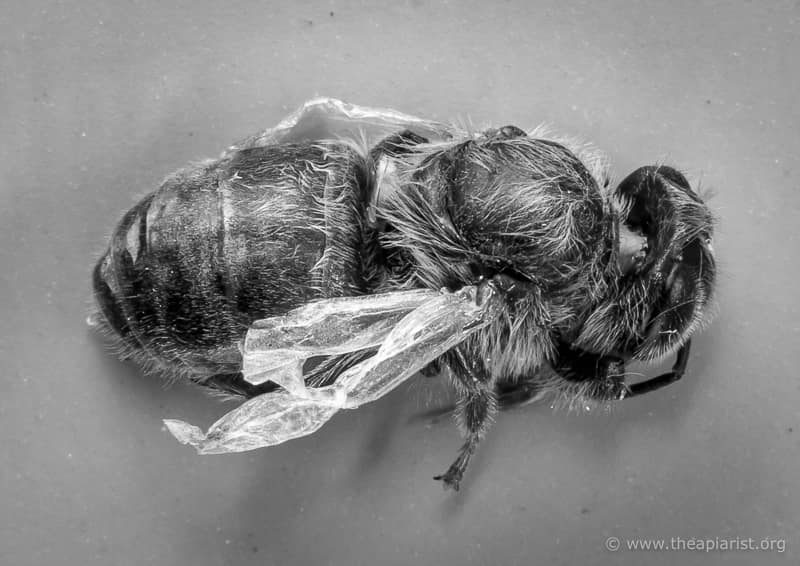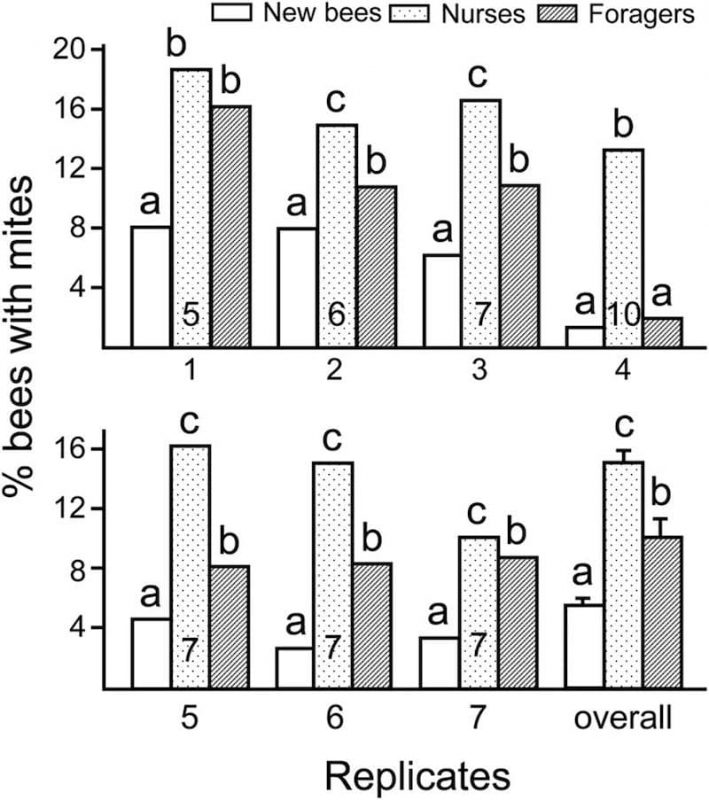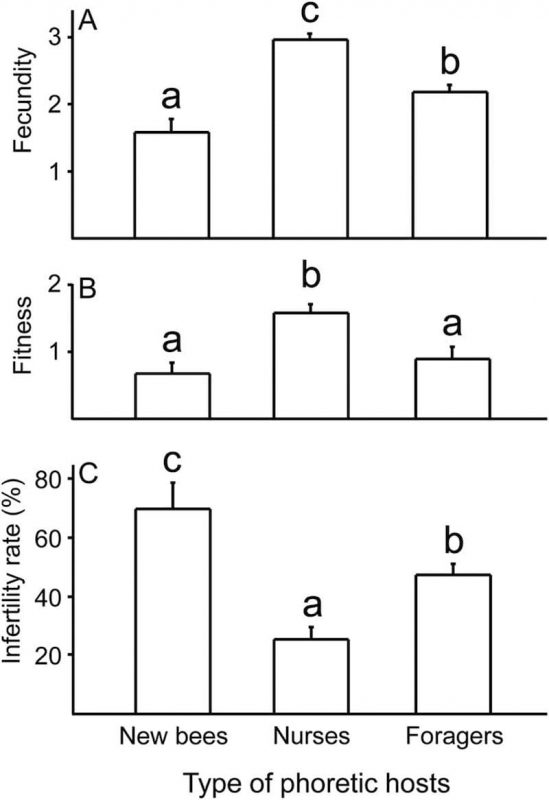Hanging around
I’ve recently discussed the misnamed ‘phoretic’ phase in the life cycle of Varroa destructor. Here we’ll briefly explore some features of this important, but non-reproductive, phase. It’s important because, as I’ll show, it influences subsequent mite reproduction.
I won’t rehash the life cycle of Varroa in detail as I’ve covered it previously. Varroa is an ectoparasite of honey bees. It reproduces in capped cells, feeding on the developing pupa. A mated female mite enters the cell a few hours before capping and she and her incestuously mated daughters are released when the bee emerges.
The longer pupal development takes, the more progeny mites are produced, so Varroa has evolved to preferentially infest drone brood.
A smorgasbord of viruses
As an ectoparasite of honey bees, Varroa is responsible for the transmission of a smorgasbord of pathogenic viruses to the developing pupa. Subsequent virus replication, particularly by the aptly-named deformed wing virus, can result in developmental deformities.
Emerging workers with deformities are rapidly ejected from the hive. Other infested workers, with high viral levels, have reduced longevity. This is probably what accounts for the majority of overwintering colony losses. It may also explain so-called ‘isolation starvation‘.
The ‘phoretic’ phase
Mites outside capped cells are termed ‘phoretic’ mites. Recent studies have indicated that these mites are feeding on the workers to which they are attached. The same studies have shaken the long-held assumption that Varroa feeds on haemolymph {{1}} by rather neatly demonstrating that it is the fat body tissue of the bee that is the plat du jour.
The duration of the ‘phoretic’ phase is dependent upon the state of the colony. Since it is defined as the phase in which mites are not associated with developing pupae, in a broodless colony all the mites are ‘phoretic’. Under these circumstances mites remain ‘phoretic’ until either brood is produced, or they fall (or are groomed) off and drop through the open mesh floor.
The duration of the ‘phoretic’ phase
In colonies with ample brood the ‘phoretic’ phase is, on average, 6 days in length. The range often quoted is 4 – 11 days. The absolute figure must depend upon a number of factors. These include the chance of a mite encountering a late-stage larva. This is presumably influenced by the amount of suitable-aged brood in the colony and – because there is a division of labour in the hive – the type of bee upon which the mite is riding around the colony on.
For the purpose of this post we’ll consider bees of three ages – newly emerged, nurse bees and foragers. Newly emerged bees (days 1-2 post emergence) clean cells and nurse bees (days 3-11) feed developing larvae. Older bees are involved in wax production (days 12-17) and foraging (>18 days until death).
Logic would dictate that mites would ‘choose’ {{2}} to associate with bees that bring them into contact with developing larvae of the right age to infest.
Do they?
Hanging around with nurses
Xie et al., (2016){{3}} assembled artificial colonies containing equal numbers of new bees, nurse bees and foragers, all suitably marked so their age was known. These colonies were provided with a queen, open brood and stores. At the start of the experiment the colonies had 1500 bees and low Varroa levels.
The scientists then introduced 200 ‘phoretic’ mites from another colony {{4}} and left the colonies for 48 hours. They then age-sorted the bees and harvested all the ‘phoretic’ mites by washing them off in alcohol.
On average, ~16% of the nurse bees had ‘phoretic’ mites attached. In contrast, only ~10% of the foragers and ~5% of the new bees had mites. These studies involved seven individual experiments, in two countries and two separate years, using a different source colony for the mites. The statistics are significant.
So mites prefer nurse bees.
Is this ‘simply’ {{5}} because the nurse bees are more likely to bring the mite into close proximity with a suitably-aged larvae?
Or does associating with, and presumably feeding on, nurse bees have other benefits for the mite?
Mite fecundity and fitness
Fecundity is the reproductive productiveness {{6}} of an organism.
We’ve obliquely tackled this subject recently. Using an in vitro artificial ‘feed packet’ system, Ramsey and colleagues demonstrated that mites fed on the fat body of bees laid more eggs i.e. they had higher fecundity.
Xie et al., also tested fecundity of ‘phoretic’ mites from newly emerged bees, nurse bees and foragers. They did this by manually harvesting mites after a 3 day ‘phoretic’ phase, adding them to a pre-pupa and then counting the number of progeny female mites 9 days later.
‘Phoretic’ mites from nurse bees exhibited higher fecundity (more female offspring), higher fitness (more mature female offspring) and lower infertility (female mites that did not generate offspring).
So evolution has elegantly resulted in ‘phoretic’ mites associating with the right type of bee to bring them close to developing larvae (upon which they reproduce) and made them better able to reproduce once they get there.
Why do Varroa mites prefer nurse bees?
This is the title of the Xie et al., paper.
Xie et al., sort of answer the question they posed in the title. What they don’t do is explain why ‘phoretic’ mites on nurse bees are more fecund. However, the recent Ramsey paper suggests that this may be because nurse bees have a larger fat body and higher levels of vitellogenin.
If they’re better fed perhaps they produce more viable offspring? {{7}}.
Another known unknown (semiochemicals)
How do mites detect the differences between new, nurse and older bees?
Perhaps they ‘smell’ different?
Mites preferentially infest drone brood because it produces a range of methyl and ethyl esters of straight-chain fatty acids, in particular methyl palmitate.
Similarly, the preference for nurse bees might be explained by their production of another semiochemicals {{8}}. If we could identify this semiochemical it might be possible to create a ‘sponge’ soaked in it that attracted all the mites in the colony.
A bit simplistic, but you get the idea.
In reality, it’s likely that nurse bees are identified by the relative strengths of a range of semiochemicals produced by bees of different ages.
In reality it’s also likely that dropping a ‘sponge’ soaked in eau de nurse bee into the colony could unbalance all sorts of other events in the hive … ?
I told you it wasn’t simple.

Rattus norvegicus
Hanging Around is the fifth track on Rattus norvegicus, the 1977 debut album of one of the finest rock/punk bands of all time, The Stranglers. The album also includes the incomparable Peaches and (Get a) Grip (On yourself), both of which were released as singles.
No more heroes from the same year, but a different album, is also a classic by the same band.
You had to be there … I was ?
{{1}}: Bee ‘blood’.
{{2}}: Nature ‘choosing’ actually means ‘that exquisite process of evolution’ … but it’s easier to write choose.
{{3}}: Xie, X., et al., Why do Varroa mites prefer nurse bees? Scientific Reports 6, 28228
{{4}}: Harvested by sugar dusting.
{{5}}: Acknowledging that there’s almost nothing simple about the association – and it’s consequences – of bees, mites and viruses.
{{6}}: In biological terms this is not the same as fertility, which is a measure of an organism to be fertilised. Fecundity is a measure of the production of eggs or young. A fertilised animal may still not be fecund.
{{7}}: Though there are several other explanations.
{{8}}: A chemical that conveys a biological message to another species.



Join the discussion ...